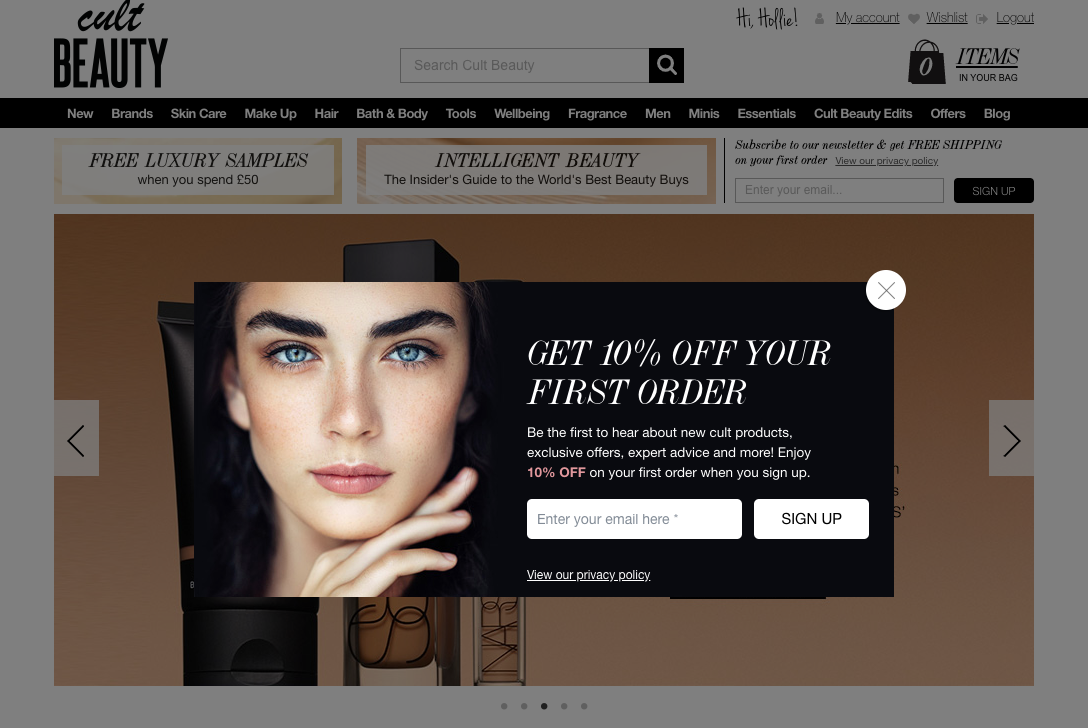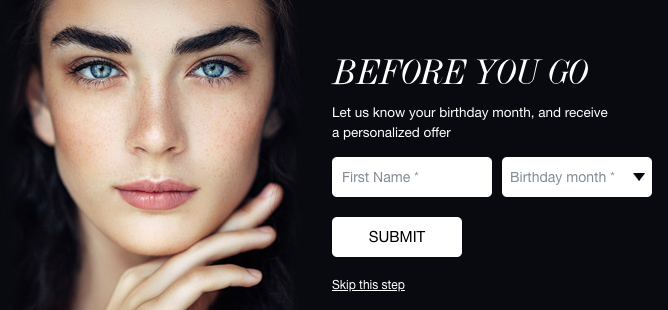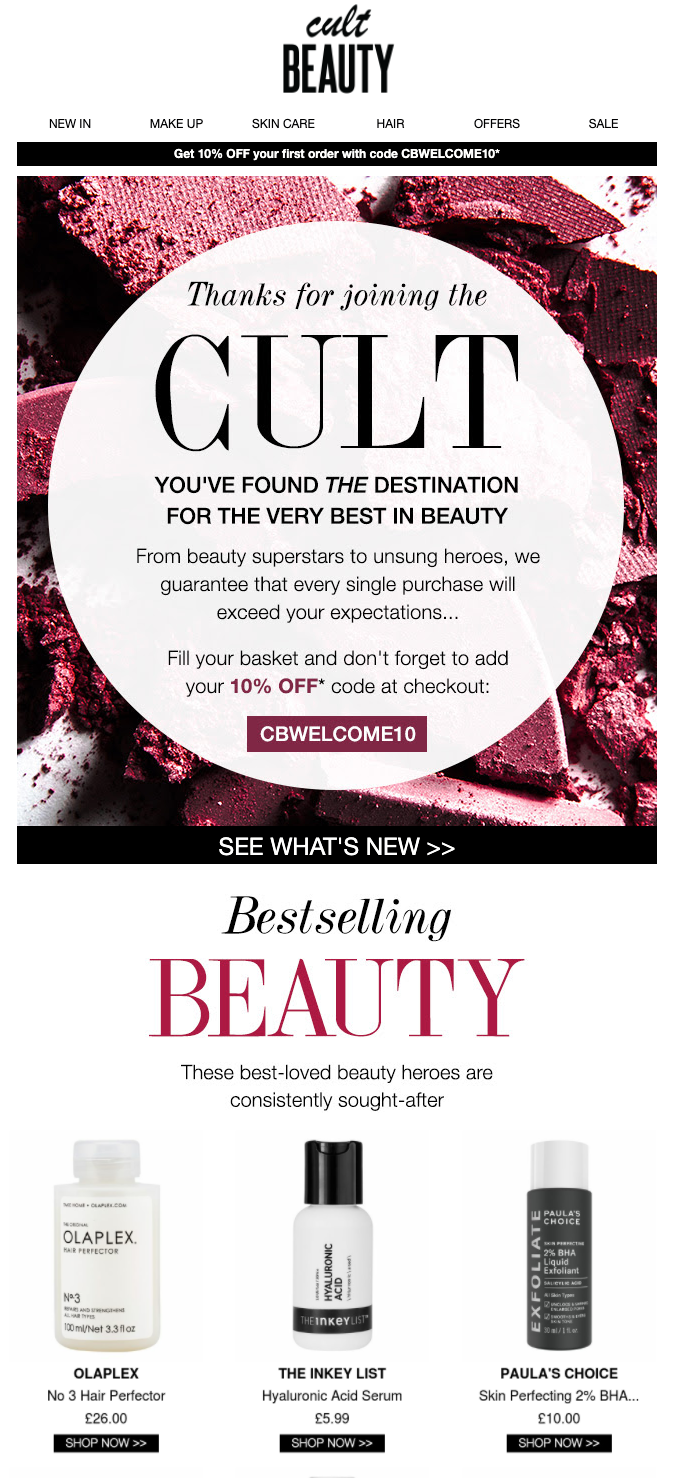Single opt-in (SOI) is the norm among email marketers and online brands. And for good reason.
It gets more subscribers on to your list, quicker. And it’s a smoother and easier process for subscribers. Plus you don’t need to worry that you might lose subscribers during the sign up process.
In the battle of single vs double opt-in, SOI usually wins for these very reasons. But it also comes with a few pitfalls.
So if you’re going to use single opt-in, do it right.
Here, Cult Beauty shows us how it’s done.
The opt in form
Firstly, to turn more website visitors into subscribers, Cult Beauty use a pop-up opt-in form, which appears shortly after landing on the website.
This grabs your attention and is more likely to convert than the static opt-in bar at the top of the page.

Secondly, Cult Beauty offers an incentive to get consumers to sign up – “10% off your first order”. This is going to appeal to anyone looking to make a purchase. And that’s the ideal website visitor for this ecommerce beauty brand.
It also means that anyone signing up to the mailing list is likely to become a customer. Which means Cult Beauty are building a highly relevant and primed audience.
Check out these three examples of successful opt-in forms for more inspiration
A second step in the opt in form
To help the brand be more relevant to their audience, Cult Beauty adds a second step to the sign-up process.

Once a visitor has entered their email address, they’re asked for their name and birthday. To avoid annoying visitors, there’s also the option to skip this step.
Many brands might ask for this additional information in a welcome email. But asking as soon as you’ve been given an email address is likely to increase the conversion rate. It’s much quicker and easier for the visitor to enter this data now when they’ve already submitted an email.
Plus it utilises the foot-in-the-door tactic, an effective marketing psychology hack. Ask for something small, and more people are likely to respond. Once they’ve agreed to that small request, they’re then more likely to agree to more requests.
Saying “thanks” and explaining what happens next
Finally, Cult Beauty thank you for signing up and tell you how you how to get your code.

This ensures new subscribers check their inbox for the email and use the code. Which will improve open rates. And increase revenue through new purchases.
However, this final message in the sign-up process does not interfere with what the consumer came to the website to do. Which is shop.
The large “SHOP NOW” call-to-action button makes sure consumers can get straight back to browsing the website.
The welcome email
Within minutes of signing up, new subscribers receive a welcome email with what was promised – that 10% discount.

Using a sign-up incentive and welcome email in tandem like this benefits your email marketing strategy in three ways:
- Increased engagement – new subscribers are going to open the welcome email to get the discount code, which means higher open rates
- Improved deliverability – the more subscribers engage with your emails, the better ISPs will rate your sender reputation so more of your future campaigns make it to the inbox (instead of spam)
- More revenue – if new subscribers are checking for this email, it’s a clear sign they want to make a purchase
Follow these 10 steps to writing the perfect welcome email
Takeaway tips
Now that you’ve seen how it can be done, here’s the key takeaways to apply to your own single opt-in process:
Make the opt-in form prominent – it’s always wise to have a static opt-in bar positioned somewhere easy to find on your key landing pages. But also experiment with pop-up forms to grab attention and increase your success rate.
Offer a sign-up incentive – if you’re using single opt-in, there’s a good chance list growth is one of your primary goals. Offering an incentive, such as a discount, in exchange for an email address is a great way to get more people onto your list.
Customise your opt-in form – use the single opt-in process as an opportunity to collect more information on your subscribers. If they’re willing to give you their email address, and if you ask straight away, they’re also going to be willing to provide a few more details. Which you can then use to personalise future campaigns.
Tell new subscribers what to expect – include a ‘thank you’ message with a note on what happens next. If you’re sending a discount code or free downloadable content, mention this on the final opt-in page.
Send a welcome email straight away – deliver your first email when subscribers are most engaged. And that’s within the first 48 hours of signing up to your mailing list. But don’t wait that long – with automation you can send a welcome message as soon as they sign up.
What next?
Now that you’ve got an idea of how to make the single opt-in process work better, it’s time to take a moment and look beyond the initial sign-up.
Because although single opt-in is great for growing your mailing list, it does expose you to issues that impact your email deliverability.
So regularly clean your list. This will ensure you’re removing invalid email addresses. And purging inactive subscribers, who are more likely to mark your emails as spam.
Combining ongoing list hygiene with a great sign-up process will make single opt-in work brilliantly in your email marketing strategy.


No Comments
Leave a comment Cancel